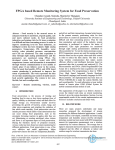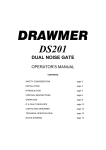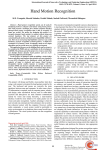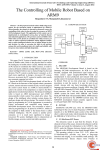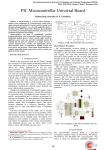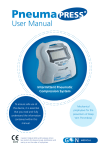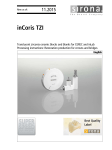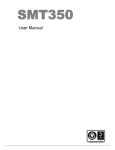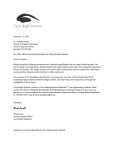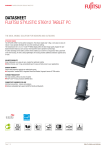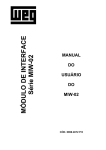Download FPGA based Remote Monitoring System for Food Preservation
Transcript
International Journal of Innovative Technology and Exploring Engineering (IJITEE) ISSN: 2278-3075, Volume-1, Issue-2, July 2012 FPGA based Remote Monitoring System for Food Preservation Sonu Rana, Rakesh Gill Abstract - Food security is the assured access to adequate food that is nutritious, of good quality, safe and meets cultural needs. In food production industries, performing visits for 24 hours evaluation is a difficult and time consuming process. In order to improve monitoring level for food industries, an intelligent system has been designed. Eight analog parameters Temperature, PH, humidity, water activity, redox potential, pressure, concentration and CO2 are monitored. The data acquisition is done through eight analog potentiometers and the parameters are monitored using FPGA. The developed system has been tested with RTD temperature sensors and information is transmitted through wireless communication to user mobile at remote place if any failures occur in the system. Thus for good food quality, FPGA and GSM based remote monitoring is performed to improve the status of production. The work represents the idea of real time monitoring and control of multi sensors food security application. The system is low cost, flexible, fast and reconfigurable. Keywords - Remote monitoring, wireless, multi sensors I. INTRODUCTION Food preservation is the process of treating and handling food to stop or slow down spoilage (loss of quality, edibility or nutritional value) and thus allow for longer storage [1]. Preservation usually involves preventing the growth of bacteria, yeasts, fungi, and other micro-organisms and retarding the oxidation of fats which cause rancidity. Food preservation can also include processes which inhibit visual deterioration that can occur during food preparation, such as the enzymatic browning reaction in apples after they are cut. Maintaining or creating nutritional value, texture and flavor is an important aspect of food preservation. During the literature survey of proposed research, various works has been found on remote monitoring for different applications. Food preservation is one of the very effective and useful applications. Major preservative factors for food are Temperature,Humidity and pH etc and their interactions, became better known. In the present scenario, performing visits for food preservation to control all parameters for 24 hours is a difficult and time consuming process. Thus for real time automation and control of the industry, remote monitoring is performed to improve the status of production. Upto eight parameters are monitored through eight analog potentiometers embedded on Microcontroller kit. To test the whole prototype system, RTD Temperature sensors are used for sensing and take decision based on the set point values and their control in order to reduce the false alarms. The data is sent using wireless communication that makes system efficient, effective and intelligent decisions based on processed data that is accurate and analyzed [5]. The Microcontroller and FPGA (Field Programmable Gate Array) kit is interfaced for data acquisition and serial Manuscript received on July, 2012. Sonu Rana, Gurgaon college of Technology & Management. Rakesh Gill, Bilaspur (GGN) MDU(ROHTAK). communication. The programming is done in VHDL (Very High Speed Integrated Circuits Hardware Description Language) and assembly language for 8051 Microcontroller. All implementation has been done on FPGA (Spartan-3E) to make the system flexible, fast and reconfigurable. To send information at user mobile located at remote place GSM (Global System for mobile communications) module is used. The organization of the paper is as follows .Section 2 covers the related work done on remote monitoring. Section 3 gives the system description. Section 4 covers experimental results of the current implementation and Section 5 includes conclusion and future work. II. RELATED WORK There are many projects undertaken and many researches proposed the development of remote monitoring for different Industrial applications. A multi sensor system is developed, controlled and tested using temperature and humidity sensors [2].The developed prototype system has been tested with RTD temperature sensors for temperature measurement over a wireless connectivity for various distances. The average loss in signal is measured and received power is calculated and compared and the effect of obstacles at indoor and outdoor range for wireless transmission has been presented. REMOTE MONITO RING TERMIN AL CONT ROL CENT RE Fig 1 Basic Architecture of the developed system Real time [3] remote video monitoring has been done for image information at construction sites through internet. The signal from cameras at sites is transmitted to monitoring terminals. The temperature and humidity is measured and compared with threshold values [4] .The information is transmitted to monitoring terminal via GSM network to mobile phone. At monitoring terminal a PC and another GSM module will be there to control temperature and humidity. The remote monitoring and control of eight parameters has been done by Zigbee based wireless communication [5]. The signal 148 FPGA based Remote Monitoring System for Food Preservation loss and power received is calculated at different distances and different baud rates and the effect of obstacles has been presented at indoor and outdoor locations. The FPGA [6] implementation of real time remote sensing system for temperature and humidity has been done .The design is based on using FPGA for the hardware implementation of the controller circuit and GSM for remote monitoring .The controller circuit has been described using VHDL. Both parameters are transmitted to mobile through GSM module and controlled at control centre through PC .The system offers low cost and user friendly way of 24 hours real time monitoring for temperature and humidity using SMS (short text message) service. A. FPGA The FPGA SPARTAN-3E is used and the programming is done in VHDL using Xilinx 9.2i tool. The Spartan family is a platform FPGA developed for high performance from low-density to high-density designs that are based on IP cores and customized. Spartan-3E architecture is optimized for high speed with low power consumption. Combining a wide variety of flexible features and a large range of densities up to10 million system gates, the Spartan family enhances programmable logic design capabilities and is a powerful alternative module. It has densities from 40K to 8M system gates, 420 MHz internal clock speed (Advance Data), 840+ Mb/s I/O (Advance Data) and 3 Mb of dual-port RAM in 18 Kbit block SelectRAM with Up to 1,108 user I/Os and 19 single-ended and six differential standards. III. SYSTEM DESCRIPTION Monitoring multiple parameters for food preservation is an important means for obtaining high-quality environment. This work presents development of a low cost multi sensor system for sensing eight input analog parameters along with reconfigurable automation, and wireless communication. Various parameters for food security like Temperature, Pressure, Humidity, Concentration, PH, Low water Activity, Redox Potential and CO2 can be monitored in 24 hours real time to improve crop production and soil status. The basic block diagram of developed system is shown in figure 1. The whole system is divided in two parts –Remote Monitoring terminal and Control Centre. At remote monitoring terminal there is an analog to digital converter, FPGA kit and a GSM module. At control centre, which can be located at any remote place inside the coverage area, there is a user mobile phone and a PC to control the whole system. To use an A/D converter, the 8051 microcontroller kit has been used which is serially interfaced with SPARTAN FPGA to get the information. The eight parameters are sensed through eight potentiometers available on 8051 kit. The 0809 A/D converter with resolution of 8 bits and total unadjusted error of +–1/2 lsb and +–1 lsb with single 5 volt power supply is interfaced with microcontroller in the microcontroller kit. The microcontroller A/D converter performs periodic scans of the sensors. The eight input sensor nodes operate under stored program control [7]. The parameters are firstly checked with eight-potentiometer kit and then module has been checked by RTD sensors [4]. Voltage (0-5V) is converted into corresponding engineering units for different parameters. Each parameter is transmitted serially at baud rate of 9600 and periodic scan of 1 second to FPGA. The eight parameter values are received continuously at FPGA at each time interval of 1 second. There is a main control switch SW1 on FPGA .The data is received at FPGA when the switch SW1 is on and the values will be stored in FPGA buffer. Now, for each parameter there is a corresponding set point value already stored in FPGA. The parameter values are continuously compared with their set point values. If it is greater or less than the set point value, as required for the application, the corresponding relay will be on. There are eight relays for eight parameters in the system and it becomes on if the parameter value does not match the required threshold one. The information is transmitted to user’s mobile phone at control centre through AT Commands via GSM module. A short message service (SMS) is sent to the user mobile for example “Control Temperature“ and according to that the parameter can be controlled manually. The set point values for each parameter [8] used are shown in table 1. B. GSM For wireless communication the GSM development board (ATM-GSM-B/A) [10] has been used which is shown in figure 2.It has 3 band communications (900, 1800, and 1900) with on-board mini SIM (Subscriber identity module) card reader. It has on board RJ11 connector for handset connection and CN1 connector is provided for 9-12V/2AMP DC input for the board directly from the DC adapter. Also, SIM card holder is provided for connecting the SIM card .The module can be connected with RF cable, which can be further connected to the GSM antenna and a 9-pin berg (serial connector) is provided for interfacing the GSM/GPRS board with target board. The central processor is P89C51RD2 with crystal frequency of 11.0592MHz and Internal FLASH Memory of 64K. The information from FPGA to GSM module is transmitted using serial communication RS 232 at baud rate of 9600. To send SMS messages, first place a valid SIM card from a wireless carrier into GSM modem, which is then connected to the device through a serial cable. After connecting a GSM modem to FPGA, the GSM/GPRS modem can be controlled by sending instructions to it. The instructions used for controlling the mobile phone or GSM/GPRS modem are called AT commands. The programming is done in Keil µvision IDE and ECE Flash .The command line used to send the text message "Control Temperature" from a FPGA to the 10 digit mobile phone number XXXXXXXXXX using the +CMGS AT command in SMS text mode is : AT+CMGS="XXXXXXXXXX"<CR>Control Temperature. <Ctrl+z> Where <CR> represents a carriage return character. C. Temperature Measurement The temperature measurement is implemented using the PT 100 Resistance Temperature Detector (RTD) sensors [5]. The transmitter circuit takes RTD as input and provides 4-20 mA output corresponding to the measuring range of 0-50°C. The XTR-103 has built-in provisions for RTD current excitation, signal amplification and liberalization on a single integrated circuit. The zero and span adjustment are carried out to get 420 mA output signals for a working temperature range of 0-50°C. These 4-20 mA current signals are interfaced to the ADC input port of the micro controller for further processing. First, temperature transmitter circuit is calibrated by connecting a standard resistance box. The resistance is set to 100Ù, corresponding to 0OC, and then ZERO adjustment is done to get 4 mA at the output. Similarly it is set to 119.4Ù, 149 International Journal of Innovative Technology and Exploring Engineering (IJITEE) ISSN: 2278-3075, Volume-1, Issue-2, July 2012 corresponding to 50oC, and SPAN adjustment is done to get 20 mA at the output. Similarly the other temperature transmitter circuits are calibrated. The authors are thankful to Dr. Kamal Thakur, Director GITM, BILASPUR for their guidance. Thanks are due to authors Jifeng Ding, Jiyin Zhao, Biao Ma, Wael M EI-Medany, Shashikant Sadistap, Satish Bindal, B. A. Botre and KSN Rao for help in reviewing their papers. Table 1 – Eight parameters and their set point values used for food preservation Set point values Freezing Temperature (T) 70C Intermediate Humidity(IM) 50% pH (PH) High Pressure (HP) Low Water Activity (aw) REFERENCES [1] [2] <7 700-900Mpa 0.72 Redox Potential (Eh) 0.73V Concentration (CN) >20% CO2 (CO2) >35% Food security is important if any disaster like earthquake or flood happens. Thus, Upto eight parameters are monitored to implement food technology and also information is transmitted to user mobile at remote control centre. Since other wireless techniques have some limitations for coverage area. Therefore, for the industries located in remote area, GSM is used having wide coverage area .All implementation for the system has been done on FPGA .FPGA has its own advantages like it is fast ,prototype is easily available, placement and routing can be done on user’s desk. The test results of the developed prototype system with RTD temperature sensors for temperature measurement over a wireless connectivity is implemented. The developed system is also useful to implement another industrial application where parameters can be changed and number of parameters can be extended too as per requirement of the application. VI. ACKNOWLEDGEMENT Fig 2 GSM Development Board (Courtesy –Advance Technology) Parameters V. CONCLUSION AND FUTURE WORK IV. EXPERIMENTAL RESULTS Figure 3 shows the serial interfacing of Microcontroller and FPGA kit. The developed module is interfaced with temperature sensors through transmitters giving 4 to 20 mA current outputs. The wireless module is connected through RS232 interface. The programming for FPGA is done in VHDL using Xilinx 9.2i tool .The RTL (Register transfer logic) schematic and simulated results in VHDL for eight parameters control at remote monitoring terminal is shown in figure 4 and 5 respectively. The simulated results for AT commands to GSM Module are shown in figure 6. When clk is high and reset is low the transmission starts and FPGA receives data one by one at some fixed span of time and store into buffer .There are eight relay outputs to monitor eight parameters .According to synthesis report, the minimum period is 11.329ns (Maximum Frequency: 88.269MHz), minimum input arrival time before clock is 7.746ns and maximum output required time after clock is 14.859ns. The percentage of Number of Slices and number of 4 input LUTs used are 7% and number of bonded IOBs are 18% .Figure 7 shows the results of the temperature measurement. The temperature measurement results are verified and found to be +/- 1% over a span of 0 to 200 0C [5]. http://en.wikipedia.org/wiki/Food_preservation Shashikant Sadistap, Satish Bindal, B. A. Botre and KSN Rao. “Wireless multi-sensor embedded system for Agro-industrial monitoring and control” International Journal on Advances in Networks and Services, vol 3 no 1 & 2, 2010. [3] Liangli Xiao, Yawen Zheng. “The Implementation of remote digital video Monitoring technology in the construction projects”. International Conference on Mechanic Automation and Control Engineering (MACE), IEEE 26-28 June 2010. [4] Jifeng Ding, Jiyin Zhao ,Biao Ma “Remote monitoring system of temperature and humidity based on GSM” IEEE,2 nd International congress on Image and signal processing ,17-19 oct 2009, Tianjin, China. [5] Shashikant Sadistap, Satish Bindal and K. S. N. Rao. “Multi-sensor embedded systems for agro industrial applications Third International Conference on Sensor Technologies and Applications, SENSOR COMM 2009, June 18-23 2009 –Athens/ Vouliagmeni , Greece. [6] Jifeng Ding, Jiyin Zhao ,Biao Ma “Remote monitoring system of temperature and humidity based on GSM” IEEE,2 nd International congress on Image and signal processing ,17-19 oct 2009, Tianjin, China. [7] Andrew Mason, Navid Yazdi and Abhijeet V. Chavan “A generic multielement microsystem for portable wireless applications”. [8] web.itu.edu.tr/~kilicmer/gid416e/FoodPreservation.ppt [9] SPARTAN-3E data sheet , ds031.pdf [10] GSM Board user Manual (Courtesy –Advance Technology, India) 150 FPGA based Remote Monitoring System for Food Preservation Fig 3 Interfacing between Microcontroller and FPGA kit Fig 4 RTL Schematic for eight parameters control at remote monitoring terminal Fig 6 Simulated result for sending AT commands from FPGA to user mobile at control centre Fig 5 Simulated result for eight parameters control at remote monitoring terminal 0 TEMPERATURE IN C 60 50 40 30 20 10 0 100 105 110 115 120 RESISTANCE (OHMS) Fig 7 Temperature Measurement 151 125





